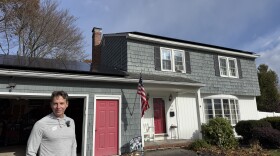More days with haze and poor air quality from Canadian wildfires are becoming the new normal for New Hampshire and much of the Northeast during the summer and early fall.
So far in 2025, the Department of Environmental Services has issued eight air quality alerts. Of those, six were issued because of increased levels of fine particle air pollution all caused by wildfires in Canada, which is on track to have its second-most devastating wildfire season on record.
Air quality specialists in New Hampshire are looking more closely at those trends than ever before, and health professionals are becoming more concerned about the effects of air pollution.
Up until the last four or five years, state air quality scientist Kathleen Simmons said that monitoring wildfires because of their potential pollution effects for New Hampshire wasn’t really something that was part of everyday air quality forecasting.
“It definitely is showing that things have started to change,” Simmons said. “Something that used to not be part of our routine is now routine. You can't deny that things are a little bit different.”
Wildfires in the Western United States and Canada have been increasing in size and severity since the 1970s, expanding the reach of smoke to areas thousands of miles away, explained Brett Anderson, a climate expert at AccuWeather.
Warmer winters and springs are partially behind that trend, as human-caused climate change heats up the atmosphere. Snow melts sooner, soils dry out faster, allowing for an earlier start to the fire season.
More humid and hotter summers create more opportunities for thunderstorms and lightning activity, which is behind most of the wildfires in Canada, even in areas that don’t normally see those conditions, Anderson added.
That was the case in 2023, when many fires erupted in northern Quebec, which is closer to New England. As a north-sound wind pattern took hold, “we experienced yellow skies, poor visibility and very unhealthy air quality,” Anderson wrote.
Similarly, this year has seen some fires closer in distance to the Midwest and Northeastern United States, which have “a potentially greater impact in terms of smoke compared to fires that typically burn in Western provinces,” Anderson wrote in an email.
That smoke carries the fine particle pollution — also known as PM2.5 — that can cause health problems for kids, older adults, people with lung diseases, and others who find themselves outdoors. (Climate change also fuels higher levels of ozone, since hotter temperatures accelerate how it's formed. Ozone pollution can also make breathing more difficult for at-risk people.)
Simmons, the air quality specialist, said people might start to experience chest pain, palpitations or shortness of breath. People may not be able to breathe as deeply or as vigorously as normal.
Read more on how to stay safe during air advisory days.
Cynthia Nichols works as nurse manager in the Dartmouth Health system and sits on the board of NH Healthy Climate, a group focused on climate change’s impact on health in the state.
She said ER’s are more closely monitoring poor air quality days.
“I've worked with nurses that said that when they worked in the ER, they kept track of the air quality specifically so they could be prepared for more people coming in with the COPD exacerbations…because of the air quality and people that are going to be coming in with more asthma attacks,” Nichols said.
But Nichols is concerned that, while monitoring air quality and reducing pollution are growing increasingly important, the resources to better do so are disappearing.
“Now we’re getting funding cuts and decreasing our emissions standards,” Nichols said. “So I think that the Department of Environmental Services is going to be stretched thin.”
Nichols is referring to the Environmental Protection Agency’s recent proposal to eliminate certain greenhouse gas emissions regulations. While fine particle pollution and ozone are naturally occurring, increasing the amount of greenhouse gases in the atmosphere could exacerbate climate change, leading to more wildfires and more extreme hot days.
“It’s all a cycle,” Nichols said.








